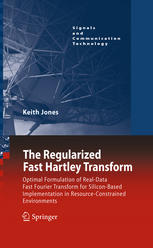

Most ebook files are in PDF format, so you can easily read them using various software such as Foxit Reader or directly on the Google Chrome browser.
Some ebook files are released by publishers in other formats such as .awz, .mobi, .epub, .fb2, etc. You may need to install specific software to read these formats on mobile/PC, such as Calibre.
Please read the tutorial at this link: https://ebookbell.com/faq
We offer FREE conversion to the popular formats you request; however, this may take some time. Therefore, right after payment, please email us, and we will try to provide the service as quickly as possible.
For some exceptional file formats or broken links (if any), please refrain from opening any disputes. Instead, email us first, and we will try to assist within a maximum of 6 hours.
EbookBell Team

5.0
58 reviewsWhen designing high-performance DSP systems for implementation with silicon-based computing technology, the oft-encountered problem of the real-data DFT is typically addressed by exploiting an existing complex-data FFT, which can easily result in an overly complex and resource-hungry solution. The research described in The Regularized Fast Hartley Transform: Optimal Formulation of Real-Data Fast Fourier Transform for Silicon-Based Implementation in Resource-Constrained Environments deals with the problem by exploiting directly the real-valued nature of the data and is targeted at those real-world applications, such as mobile communications, where size and power constraints play key roles in the design and implementation of an optimal solution. The Regularized Fast Hartley Transform provides the reader with the tools necessary to both understand the proposed new formulation and to implement simple design variations that offer clear implementational advantages, both practical and theoretical, over more conventional complex-data solutions to the problem. The highly-parallel formulation described is shown to lead to scalable and device-independent solutions to the latency-constrained version of the problem which are able to optimize the use of the available silicon resources, and thus to maximize the achievable computational density, thereby making the solution a genuine advance in the design and implementation of high-performance parallel FFT algorithms.